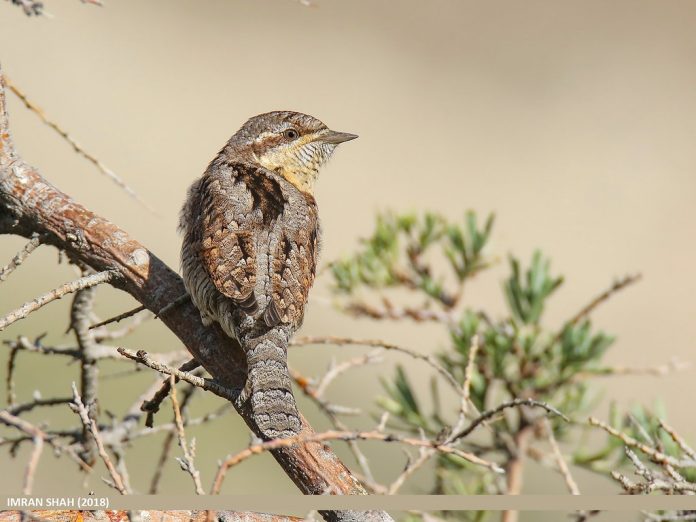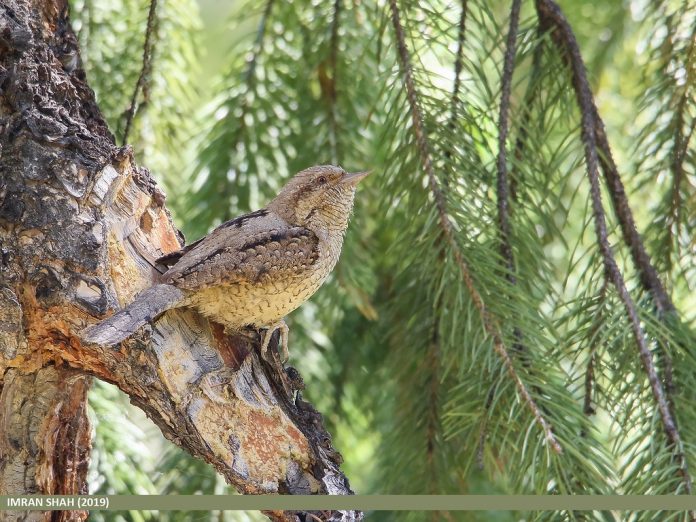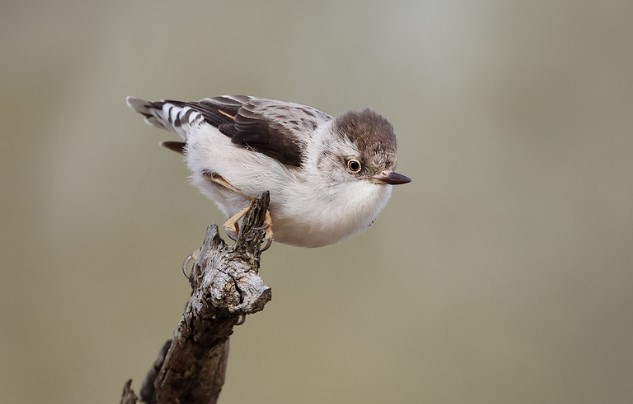Page Contents
IDENTIFICATION
Eurasian Wryneck is 16–17 cm in length and 25–27 cm with wingspan. This small, aberrant woodpecker is a most inquisitive bird, looking and behaving much more like a smallish passerine bird than a woodpecker. This bird species resembles a large warbler, a small shrike, or even a small, slender thrush with beautifully vermiculated, cryptic plumage (in a poor view looks rather uniform grayish-brown, however).
Eurasian Wryneck has a relatively small head and small bill, and a fair long, rather soft tail. Interestingly the small legs are the only woodpecker-like feature. Unmistakable at close range, when its almost nightjar-like plumage pattern and color can be seen well, but at a distance tends to be identified more by elimination than by anything else.

Somewhat lacking in noticeable plumage features from any distance, but from above and behind dark brown bands bordering the crown, extending from the center of nape to mantle and along the edge of scapulars stands out in good light. Do not clamber up tree trunks (although occasionally clings to trunk), and drums only softly by tapping on a branch.
Eurasian Wryneck is a bit shy, unobtrusive, and rather lethargic, often staying hidden in trees or bushes. However, at the times of feeding, it appears on the ground-hopping about with the tail slightly raised. Habitually sits silently for long periods on an overgrown wall or branch of a tree.
But when pressed, defends itself by fanning tail, erecting crown feathers into the short crest, extending neck, and twisting and turning head from side to side (therefore its vernacular name). Also, the flight is low and somewhat undulating with quite long glides on partly-closed wings, more often than not over comparatively short distances between trees or bushes.

SEX/AGE
The juvenile very closely resembles an adult at any distance but is a little duller and browner. The bird has crowned and hind neck browner, less gray, with more evident dark and white barring. The bird has a less well-defined black area from hind-neck to mantle, and feathering of the back, rump, and upper-tail coverts soft and loose with creamy-white ground coloration and a number of narrow dark barring (in its place of tight gray feathering with fine dark speckling). The ground color of tertials and outer scapulars warmer (rufous-cinnamon), is less gray.
Further, the cream spots on the tips of longer wing coverts are less well-defined. Also, the upper breast, throat, and flanks are less rich buff, dark barring paler (gray rather than black), and less sharply defined. The beautiful tail with more pronounced black barring.

CALL
Eurasian Wryneck calls, often revealing presence for the first time, a repeated clear ringing but plaintive ‘queeequee- queee-queee-queee’ (each unit falling in pitch at the end). Eurasian Wryneck is stronger, more metallic sounding, and more plaintive than the same as the call of Lesser Spotted Woodpecker, recalling Common Kestrel or Eurasian Hobby.
HABITAT
Eurasian Wryneck is fairly common, but locally decreasing. (In addition to is now only irregular breeder in Britain, were once widespread and has bred Mallorca. It spends most winter south of the Sahara. Woodland (with edges and clearings, favoring broadleaved but also found in coniferous), open woodland, orchards, parks, large gardens. Outside breeding season, also in the scrub. The persistence of a wryneck population seems to depend primarily on the presence of orchards, especially on the availability of old pear trees. Lookout, such as poles, trees, fences, and shacks, are a vital habitat feature for wrynecks which are perch-hunters, with perches enhancing nest detectability.

A richly-structured mosaic agricultural is also helpful as wrynecks tend to stay longer in territories contributing higher local habitat heterogeneity (number of parcels and or culture types) than average, perhaps due to edge effects favoring ant abundance and or to detectability and convenience of their nests. Although mainly of intensively managed orchards, the abundance of food resources (ants) did not seem to be a limiting factor, at least at the current wryneck density.
TERRITORY SELECTION
Wrynecks selected territories not randomly and the best territories were settled earlier in the season. Moreover, the territory colonization probabilities differed between years, whereas the extinction probability remained constant. This indicates that colonization also depends on time-dependent factors: (e.g. weather-induced variation in food resource availability and/or foraging habitat accessibility; or it may indicate also a considerable amount of stochasticity. The taken as a whole food supply inside territories, habitat-specific ant nest densities are multiplied by their proportional area of territory and summed.






